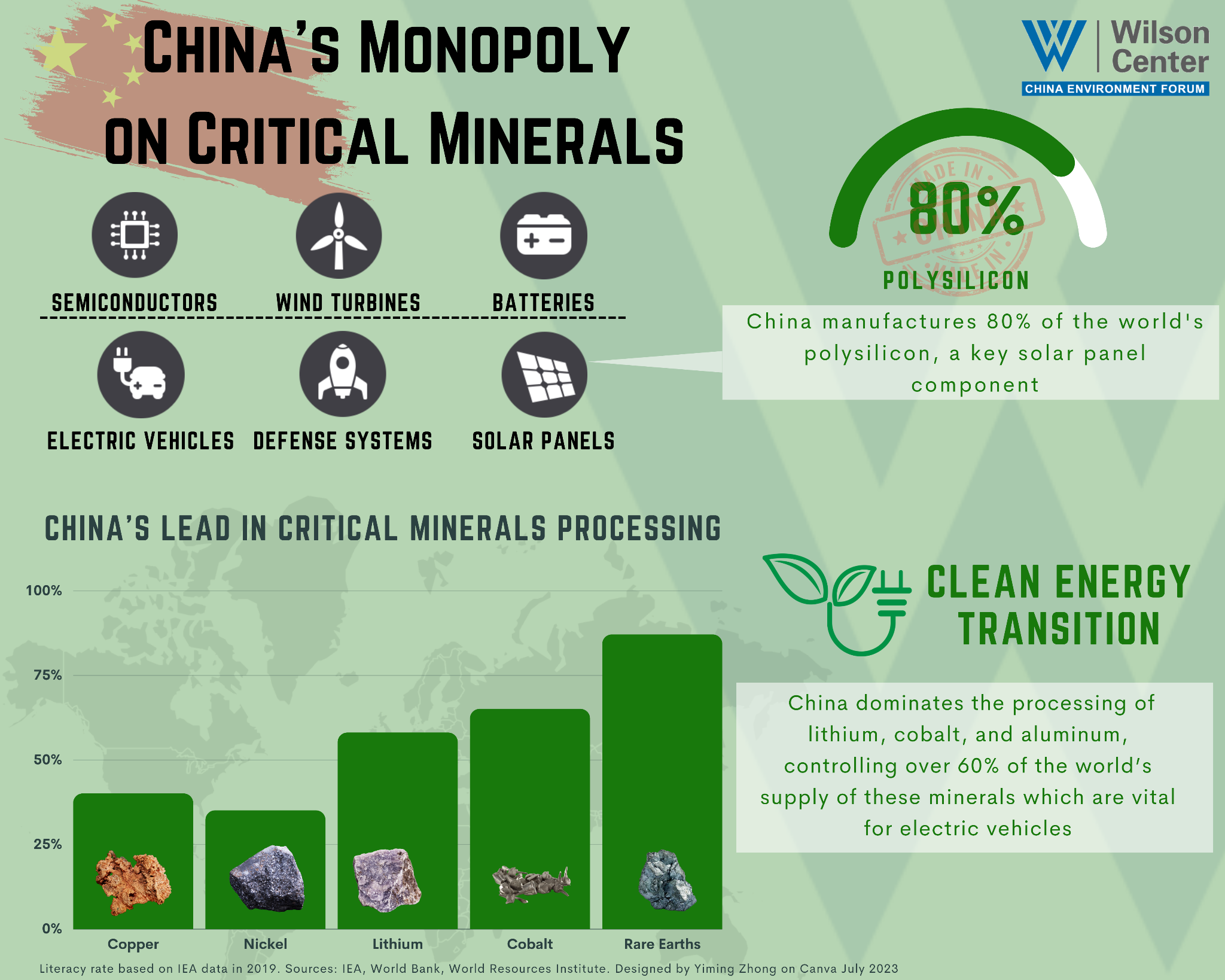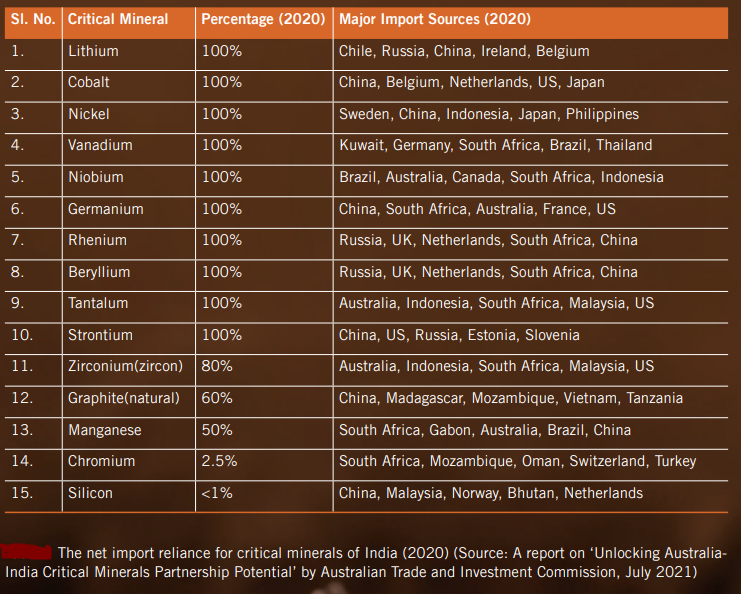Important Facts For Prelims
China’s Export Restrictions on Critical Minerals
- 14 May 2025
- 7 min read
Why in News?
India is engaging with China over export restrictions on germanium, a critical mineral vital for semiconductors.
- China, which produces over half of the world's germanium, has restricted exports of this critical mineral, impacting industries in India that depend on imports.
- These export restrictions are part of China’s strategy to protect national security, retaliate against U.S. tariffs, and strengthen its control over global supply chains.
About Germanium
- About; It is a lustrous, hard, silvery-white semi-metal with a crystal structure resembling that of diamond.
- Application: It is widely used in electronics and optics, especially in fiber-optic cables, infrared imaging devices, and fiber-optic preforms, which are crucial for internet infrastructure.
- It is also used in solar cells due to its heat resistance and higher energy conversion efficiency.
- Global Production: China is the world's largest producer and exporter of germanium, accounting for 60% of global germanium production.
What are Critical Minerals?
- About: Critical minerals, such as copper, lithium, nickel, cobalt and rare earth elements are essential components of many of today’s rapidly growing energy technologies, from wind turbines and electricity networks to electric vehicles.
- India has identified 30 critical minerals, including Antimony, Beryllium, Bismuth, Cobalt, and Germanium.
- China dominates the global processing of several critical minerals, including rare earths, controlling an estimated 80–90% of processing capacity.
- Significance for India: They are vital to renewable energy technologies that will be required to meet the “Net Zero” commitments of the countries around the world.
- Critical minerals are essential for making EVs, solar panels, and electronics.
- With India’s EV market set to grow at 49% CAGR till 2030, reaching 1 crore annual sales, demand for critical minerals and advanced chemistry cell (ACC) batteries will rise sharply.
- Critical minerals drive innovation in AI, robotics, and space technology, supporting India's Atmanirbhar Bharat vision for technological self-reliance.
- The Economic Survey 2022–23 warns they may become geopolitical flashpoints like crude oil.
- Critical minerals are essential for making EVs, solar panels, and electronics.
- India’s Dependence: India is heavily dependent on imports for critical minerals, particularly from China.
- These minerals, including bismuth, lithium, and silicon, are essential for industries such as pharmaceuticals, semiconductors, and aerospace.
What are the Major Applications and Availability of Critical Minerals in India?
|
S. No. |
Critical Minerals |
Major Applications |
Availability in India |
|
1 |
Cadmium |
Manufacture of electrical equipment, Chemical products, Solar cells, Electroplating, and Silver soldering |
Cadmium is recovered as a by-product during zinc smelting and refining. |
|
2 |
Cobalt |
Electric Vehicles (EVs), Batteries, corrosion resistant alloys, Aerospace applications, Pigments and Dyes, Organic and inorganic chemical compounds. |
Not available.Current requirements are made through imports. |
|
3 |
Copper |
Electrical and electronics products, Electrical Wiring, Solar Panel, Automotive industry. |
Current copper concentrate production meets only 4% of the demand for copper smelters and refineries, requiring substantial imports. |
|
4 |
Gallium |
Semiconductors, Integrated Circuits, LEDs, Specialized thermometers, Barometric sensors. |
Gallium is recovered as a by-product while producing alumina. Two plants, namely, HINDALCO at Renukoot, Uttar Pradesh and NALCO Damanjodi alumina refinery, Odisha, had recovered Gallium in the past. |
|
5 |
Germanium |
Optical fibers, Satellites, Solar cells, Infrared night vision systems. |
Not available. Current requirements are made through imports. |
|
6 |
Graphite |
Batteries, Lubricants, Fuel cells for EVs, Electric Vehicle |
9 million tonnes reserves exist. |
|
7 |
Lithium |
Electric Vehicle, Rechargeable batteries, Glassware, Ceramics, Fuel manufacturing, Lubricant. |
lithium-inferred resources of 5.9 million tonnes in the Salal-Haimana area of the Reasi district in J&K. |
|
8 |
Nickel |
Stainless steel, Solar panels, Batteries, Aerospace, Defence applications and Electric Vehicle. |
Vedanta has a nickel and cobalt plant at Goa named NICOMET. |
|
9 |
Rare Earth Elements (REE) |
Permanent magnets, Catalyst, Polishing, Batteries, Electronics, Defence technologies, Wind energy sector, Aviation and Space |
The resource estimate of Monazite from beach sand in India is 11.93 Mt having 55%-65% of rare earth oxides. |
|
10 |
Silicon |
Semiconductors, Electronics and transport equipment, Paints, Aluminum alloys |
India reported production of 59000 metric tonnes of silicon and ranks 12th in production as per 2022 data. |
What are India's Initiatives for Achieving Self-Reliance on Critical Minerals?
UPSC Civil Services Examination, Previous Year Questions (PYQs)
Q. Recently, there has been a concern over the short supply of a group of elements called ‘rare earth metals’. Why? (2012)
- China, which is the largest producer of these elements, has imposed some restrictions on their export.
- Other than China, Australia, Canada and Chile, these elements are not found in any country.
- Rare earth metals are essential for the manufacture of various kinds of electronic items and there is a growing demand for these elements.
Which of the statements given above is/are correct?
(a) 1 only
(b) 2 and 3 only
(c) 1 and 3 only
(d) 1, 2 and 3
Ans: (c)









